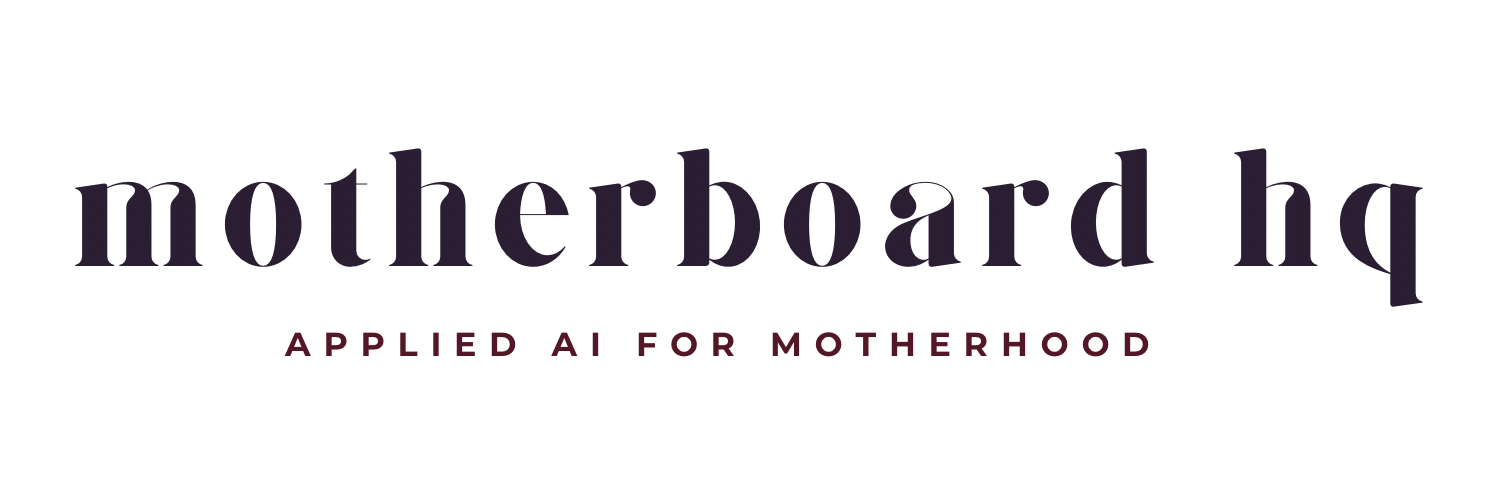How to Use ChatGPT for Moms: A Real Guide (When You’re Too Tired to Think)
ChatGPT can hold things for you when your brain is maxed out. This guide shows you how to actually use it for the invisible labor of motherhood — no hype, just practical prompts and real examples for when you're too tired to think straight.

If you’re wondering how to use ChatGPT for moms — whether it actually helps with the mental load or if it’s just another productivity gimmick — this guide breaks down what works and what doesn’t.
First and foremost, I’m not going to sell you on ChatGPT like it’s some productivity miracle that’ll turn you into a perfectly optimized supermom. That’s not what this is.
But here’s what it can do: ChatGPT can hold things for you when your brain is maxed out and literally cannot hold one more thing.
If you’re here because you’re chronically overwhelmed, mentally spent, and lowkey curious about whether AI can actually help with the invisible labor of motherhood — welcome, you’re in the right place.
What Is ChatGPT and How Does It Work?
ChatGPT is a language model. That means it’s trained on a massive amount of text and can generate responses based on patterns it’s learned. It’s not sentient, it’s not magic, and it’s definitely not going to replace you or your ability to parent.
What it is good at though:
- Processing information faster than your overstimulated nervous system can
- Generating structured responses when you can barely think straight, let alone form a coherent thought
- Holding context so you don’t have to keep everything in your head at once
- Acting as a cognitive offload system when decision fatigue hits
Think of it less like a robot assistant and more like an external hard drive for your mental load.
How to Use ChatGPT: 4 Practical Steps for Moms
1. Be specific, not polite
You don’t need to say “please” or “thank you.” You’re not bothering it. Just tell it what you need.
Instead of: “Hi! I was wondering if you could maybe help me plan meals?”
Try: “I need 5 dinners. No dairy. Under 30 minutes. Nothing that requires me to think too hard.”
2. Give it context (but not your life story)
ChatGPT works better when it knows what you’re working with. You don’t need to explain why you’re overwhelmed — just give it the parameters.
Example: “I have a 4-month-old who won’t nap. I need to respond to 6 emails today. Help me draft a response that sounds professional but takes 30 seconds to edit.”
3. Iterate. Refine. Don’t accept the first draft.
The first response is usually generic. Push back. Ask it to rewrite. Make it match your tone. This isn’t one-and-done — it’s a conversation.
4. Use it for the stuff that drains you, not the stuff that matters
ChatGPT can draft the kindergarten teacher email — easy peasy. It can generate a grocery list — done. It can even help you structure your thoughts when your brain feels like straight noise.
It cannot (and should not) replace the actual human parts of parenting — the messy, emotional, embodied stuff that only you can do.
Real ChatGPT Prompts for Moms (With Examples)
When your brain is completely tapped out and you need something that actually works, ChatGPT can handle specific tasks that would otherwise drain whatever’s left of your cognitive capacity.
You can use it to draft meal plans when deciding what’s for dinner feels impossible. You can use it to write emails when you’re too touched out to form sentences. You can use it to break down overwhelming tasks into steps you can actually execute.
If you’re in the thick of toddler meltdowns and need immediate help, I have specific prompts for when you’re about to lose it that work with ChatGPT’s free version — they can talk you down before the spiral takes over.
When you’re dealing with sleep regressions and googling at 2am trying to figure out what the hell is happening, ChatGPT can help you understand what’s going on developmentally. I wrote a whole breakdown on the 8-month sleep regression that includes prompts for generating a plan that doesn’t require you to become a sleep expert overnight.
And when you just need to survive the day-to-day chaos of early motherhood, having a system of ready-to-use prompts means you’re not starting from scratch every time you need help. You can offload the mental work of figuring out what to ask and just get straight to the answer.
The Mistakes Everyone Makes (Including Me)
Over-relying on it without thinking
ChatGPT is a tool, not a brain replacement. If something feels off in its response, trust yourself. You’re still the one making decisions.
Asking vague questions and getting vague answers
“Help me with dinner” → useless response.
“Give me 3 one-pot dinners I can make with ground beef, rice, and whatever vegetables are about to go bad” → actually helpful.
Not customizing the output
The first draft is never the final draft. Edit it. Make it sound like you. Use it as a scaffold, not a script.
Forgetting to proofread
AI makes mistakes. It hallucinates facts. It gets things wrong. Always double-check before you send/publish/act on anything it generates.
The Part Where I Get Real With You
Using ChatGPT does not make you lazy. It doesn’t mean you’re outsourcing motherhood. It doesn’t mean you’re doing it wrong.
It means you’re using the tools available to you to reclaim cognitive space in a world that expects mothers to be infinite.
You’re not a robot. But you can use one to help carry the load.
Frequently Asked Questions
Is ChatGPT free for moms to use?
Yes, ChatGPT has a free version that works for most of the prompts in this guide. You don't need to pay for ChatGPT Plus unless you want faster responses or access to advanced features. The free version is enough to offload mental load, draft emails, plan meals, and use the prompts in the 7-prompt pack
Can I use ChatGPT on my phone?
Yes, you can use ChatGPT on your phone through the website at chat.openai.com or by downloading the ChatGPT app. The app works on both iPhone and Android. You can type or use voice input, which is helpful when you're holding a baby or too tired to type.
Do I need to know how to code to use ChatGPT?
No, you don't need any technical skills. Using ChatGPT is just like texting — you just type what you need and it responds. The prompts in this guide are written in plain language. You're not coding or programming anything. You're just having a conversation with a tool that can think faster than your exhausted brain can right now.
What's the best ChatGPT prompt for overwhelmed moms?
Start with asking ChatGPT to break down one overwhelming task into 3 steps you can actually do. Example: “I need to plan dinner, do laundry, and respond to school emails. Break this into 3 steps I can handle right now.” If you want more ready-made prompts like this, the free 7-prompt pack has copy-paste questions for the moments when you’re too tired to think.
Will ChatGPT replace my ability to parent?
No. ChatGPT can't replace the human parts of parenting — the empathy, the intuition, the physical presence your kids need. What it can do is handle the cognitive tasks that drain you so you have more capacity for the parts that actually matter. It's not about outsourcing motherhood. It's about reclaiming mental space in a world that expects you to be infinite.
Your brain is maxed out. You don’t have space to figure out what to ask ChatGPT on top of everything else you’re holding.
I made seven prompts for when you’re too tired to think — copy-paste questions for dinner, partner communication, overwhelm, and the moments when your brain has left the building but the day isn’t over yet.
Free. Works with ChatGPT’s free version. Zero fluff.
Written by Shae — alt mom, developer, M.S. in Psychology. Fascinated by using AI to translate developmental research into survival tools for parents. Real experience where she’s lived it, evidence-based prompts where she hasn’t.

